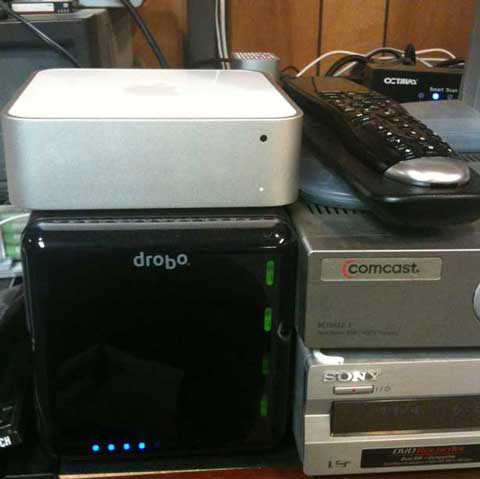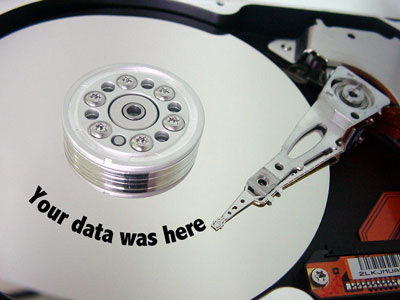“Terry have you ever done a post or video on your photo storage workflow?”
This was a question one of my Adobe Colleagues, Tim asked me last month and after a few moments of blank stares I replied, “hmm, um, no.” The reason this caught me off guard is that while I have certainly talked about photography, computers and the importance of backup over the years on my own blog, I haven’t really put it all together specifically for photographers. I thought this might be a timely topic for my guest spot here. This is also the time where I have to give one of those Scott Kelby like disclaimers and say “This is MY workflow. It’s the way I do it. I understand that your workflow and requirements may be different. So take it for what it’s worth.”
Your digital images are your negatives – PROTECT THEM!
Let’s start with what happens at the shoot
My interests are primarily around portrait, fashion and glamour photography. This means that I’m either shooting on location or in my studio. If it’s the latter then 99% of the time I’m shooting tethered into Adobe Photoshop Lightroom 3 running on my MacBook Pro. If I’m on location then chances are I’m shooting to a memory card in my camera. In either case I don’t leave the shoot without doing a backup. If I shot tethered to my laptop then the images are on my internal hard drive. That’s not good enough. Why? Because what if my drive crashes or becomes corrupted before I get home? What if my laptop is stolen between the studio and my trip home? Not likely, but I don’t chance it. I plug in a portable external Firewire 800 hard drive and copy the shoot folder over to it while I’m tearing down/packing up my gear. I think the longest it has ever taken is about 7 minutes. For me that 7 minutes is peace of mind. Either put the drive in a separate bag or in your pocket so that it’s not with your computer in case of theft (yes I’m paranoid and you should be too. How many hours did you just spend on that shoot?). If I shot to the card then I back up the card to a portable backup device such as the iPad with the Camera Connection Kit (see my review here), HyperDrive Color Space (see my review here) or the outrageously expensive, but very good display of the Epson P6000. Then I head home for more fun.
Have you ever lost or misplaced a Model Release Form?

Although I haven’t lost one, I did have a heck of a time finding one recently. It was over a year old and someone want to purchase one of my photos to use for a tutorial and patent application. I finally found the “paper” form and immediately scanned in all the rest of them. Now I no longer use paper release forms. I do them on my iPad instead. This way a copy of the signed form gets emailed to the model (or property owner) and myself. Once I get back to my computer I move it to my server for digital safe keeping.
The App I use on the iPad (works on iPhone and iPod touch too) is called Easy Release and you can get it here from the 
If you’re looking for an App that is completely customizable for all kinds of forms then I would go with Contract Maker Pro here from the 
Signing with a finger is cool looking, but get a stylus! Your model/property owner will appreciate it more. This is the one I use.
Also check out my other favorite iPad Apps for photographers here.
Review, Edit, Retouch and Distribute
The next step in my process is to go through the shoot and immediately kill the bad shots. I use the Reject flag in Lightroom 3 for this. If you’re using Star ratings, these would be the 1 Star images (unless you’re one of the backwards thinking people that believe 1 Star is the best :) In your case these would be the 5 star images – BTW, how was that 1 star restaurant you went to or the 1 star hotel you stayed in? I’m just joking. Put down the keyboard, back away. It was just a joke.) The rejects are the ones not suitable for anyone’s eyes. These are the mistakes, out of focus or otherwise horrible shots. The ones that remain are the ones that I choose my favorites from as well as provide to the client to review via the web (see my choice of Lightroom client review web template here). Before creating that web gallery I do convert my Nikon RAW files (.NEF) into DNG format. I do this with one command in Lightroom and yes I do replace the original RAW files (remember my disclaimer above?). I’ve done it this way for several years and have yet to ever miss the proprietary .NEF files.
Another Backup Has Happened in The Background – The minute I get home and open my laptop another backup kicks in automatically and wirelessly. Because I’m on a Mac with Mac OS X 10.6.x Snow Leopard, there is a native automatic backup solution that backs up any changes to my drive every hour. That solution of course is called “Time Machine.” I have a 1TB hard drive connected to my Mac mini file server (more on that in a minute) that serves as a network Time Machine backup. So even while I’m working on the shoot that I just did it’s being backed up AGAIN. Now I have the images in at least 3 places for the time being.
You’re Happy and the Client is Happy – Now What?
I’ve talked about this in the past and even recorded a video on how I handle it. See it below. The question becomes, what do you do with the hundreds of photos you snapped that no one wanted? Again I know that everyone’s situation is different. I also know that some of you may even be contractually obligated to hold on to every frame you captured. I would dare say though that most of us don’t have those restrictions. Here’s the situation: Let’s say you did a shoot and you kept 300 shots from it. You picked out the 10 favorites that you will use. Let’s say the client picked 20 and paid you. Now you’re left with 270 shots that no one chose. You didn’t want them. They didn’t want them. By the way in all my years of shooting I have NEVER had a client come back and say, “hey, you know that shot that made my nose look funny or my belly stick out? Well I want that one now.” It has never ever ever happened to me. I found that I was holding on to thousands and thousands of images that no one would ever ask for and that I would probably never go through again. Even out of the 10 or so favorites that I picked, chances are that I would only use a couple of them. If I ever needed a “different look” from that shoot, I could just pick another one from my favorites. Also remember that you typically show people your BEST work right? When do you ever go back and dig up the second or third best shots to show?
DELETE THEM!
That’s right! I said it. Delete them (see my disclaimer above before you argue your particular situation). Really? yes DELETE THEM. When you actually choose to delete them, is up to you. However, ultimately you’re better off by deleting them. If deleting them right away makes you squimish then decide WHEN you should delete them. Six months later, one year later, whatever it is, DELETE THEM!
For my Lightroom brothers and sisters out there I have a way to identify which ones to delete. I built a Smart Collection to keep a constant watch on the photos that no one choose. Here’s the video on how I did it:
Now that you’re left with the keepers where do they go?
At this point I’ve done all that I’m going to do with these photos. The client is happy. I’m happy and I left with how many ever photos that I’ve retouched or tweaked on my MacBook Pro hard drive. After a while of doing this my drive space is going to dwindle. So it’s time to MOVE them to another more permanent location. I treat my MacBook Pro as my work in progress machine. Once the shoot is complete and I’m moving on to the next shoot, I need to move those photos off to another location. This is where my Server comes in. I have a Mac mini running Mac OS X Server with a Drobo Firewire 800 attached. This server has Terabytes of space in it and no matter how much current storage I have, I know that I’m going to need more in the future.
Your need for space is never ending. You might as well accept that fact.
I had to come to the realization that as a photographer I’m going to constantly be ADDING to my collection of photos presumably for the rest of my life. Think about it. You are always going to be taking photos and even if you only kept 20 photos from every shoot, you’re probably going want access to each set of those 20 photos for life. They are your memories. Client work may be different. You probably want to archive those shots, However, for me I kinda treat them as one in the same. In other words if I do portrait session for a paying client, I will probably still have my favorites from that shoot as well as their favorites. Some may actually make it in to my portfolio. Therefore I want access to my best shots at all times. I don’t Archive! Nope, I don’t store client shots any differently than I do my personal ones. Managing multiple archives is more hassle for me than it’s worth.This is why I went with a Drobo. Before Drobo I was just using the largest hard drives available at the time and of course backing them up. Each drive would last me a year or two before I would need to increase my storage space. This is when the pain would come in because it would require being down for a day while I restored all of my files onto the new larger drive. That pain was cured for me with a Drobo. This is because I can simply Add/Replace the drives with Bigger Drives without shutting down or stopping the work.
Time to move the shoot folder from my MacBook Pro to my Server/Drobo
The remaining shots get moved over my network from my laptop to my server. I keep the catalogs on my MacBook Pro as I constantly use them and add more photos to them (unless I created a projected specific catalog for a project that then gets moved to the Drobo as well). The next time I fire up the Lightroom Catalog it will ask where the photos are (by displaying question marks on the thumbnails) and I simply point one of them to the new location of the photos on my server and Lightroom relinks all of the ones in that folder.
Lastly, I backup the Drobo every night and I have an offsite copy too
Drobos are GREAT protection for drive failure AND they give you the ability to increase your storage on the fly with little to no down time. However, what Drobos don’t protect you from is file corruption, accidental deletion and viruses. Let’s say you accidentally drag a folder over to your Drobo that just happened to have the same name as a folder already there. Yes the operating system will ask you if you want to replace the folder or not and while you meant to click NO, you accidentally clicked YES. Now that older folder is GONE! There isn’t a thing Drobo will do to help you in that case. However, if you have a backup you can restore the folder.
photo compliments of iStockphoto.com
How in the heck do you back up a Drobo?
Luckily for me my storage needs have yet to exceed the current capacity of the largest single volume drives (2 TBs) available. Since I don’t have more than 2TBs of data on my Drobo I can backup to the entire Drobo to a single 2TB external Firewire 800 drive. As a matter of fact I have TWO of these. I backup the Drobo each night using the Smart Update Feature of SuperDuper!, which only backs up the changes as needed. One drive is connected for the nightly backup and I rotate between the two drives each week between home and my safe deposit box at the bank. OK, I’m lying. I wish it were every week, but it’s more like when I remember to do it or get paranoid. In any case I have a duplicate copy of my Drobo and all my files and photos at the bank. If you think backing up a Drobo is overkill, read about my experience here. If my storage needs ever exceed the largest single drives available then I would order a second Drobo to back up the main one and then just rotate the drives from the Backup Drobo with ones in the Safe Deposit box.
The Bottom Line
I don’t proclaim my workflow to be the end all be all workflow for everyone to adopt. My goal here was to simply share what I do and why I do it. Take from it what you need and leave what you don’t need. I’ve used this method for years now and it has worked well and have the years of photos to show for it. Also by becoming more disciplined about what I keep and don’t keep, my storage requirements don’t increase as quickly as they once did.
You can see more of Terry’s photography here.













What’s up with all the portraits in corn fields?
Actually it was a Landscape workshop. I just happend to get my photo taken there during one Joe’s lighting setups. :)
Great Post, Terry, and very informative :-)
For Tony, you check out this post, that’s where the corn field picture is from :-)
http://bit.ly/1qa75V
Cool, thanks Jesper too for the link showing the setup. -T
TW, great blog and info! I have over 1/2 million pics and I’m sure 9/10 of them can be deleted. I have an HP server. If I deleted a bunch from my computer hard drive will the server pick that up or keep the pics for a period of time?
KT
Thanks Ken!
Good stuff, especially the stuff about actually deleting pictures.
I think a lot of people dont understand that they are just pushing a problem into the future if they dont delete the rejects right away.
I´ve had that problem and i still do to some extent, i got pictures from several years back that will never see the light of day again. So i sit down now and then and go through them and freeing up space on my harddrives. And believe me, it takes time, time that i could spend doing something a lot more fun.
The sooner one realizes this, the more time you get to do more fun stuff. :)
Nowadays i do have a great solution working perfect for me. I delete a lot in camera on location, cause i shoot a lot when i´m working. Then in the computer i reject very harsh, only the best ones get to stay. And the rest is bye bye.
There is really no other way, not for me.
Hi Terry, Great Post ! I’m ok with you !! Two Drobow is the good solution!!!It’i mine too! Scott Bourne talk also about another product on this post : http://photofocus.com/2011/01/10/are-your-photos-backed-up-my-new-photo-backup-tools-archive-strategy/
I find it more expensive, but seems good!
There are some real horror stories regarding Drobo. Here’s one:
http://photography-thedarkart.blogspot.com/2010/09/end-of-my-tether-with-drobo-iscsi.html
*ya, ever product has horror stories, but the way kelby (& i guess white) swear by it, basically calling it bullet-proof, it seems very biased. So another POV is only fair.
I don’t remember ever saying bullet proof and as a matter of fact I’m pretty sure that I said it needs to be “backed up” too. But thanks for being fair :)
As Terry says, whether Drobo or just a regular NAS, you should back it up. And I agree, best current practice is to a very large single drive, perhaps a pair and rotate them as off site backup. 3TB coming soon, 4 on the horizon and large capacity laptop drives may be the future, given the urge for drive farms to save on energy costs. That demand might push capacity and drive cost down so 2.5 inch drives reach a near parity with 3.5 inch, though no 9.5mm.
Is there any way to get Lightroom to make a backup to a 2nd hard drive when using tethered shooting, like the way the import does. That would sure save time copying over the files after the shoot.
Hey Terry
A great post. I guess quite a few of us find it difficult deleting things, with the thought of “it may come in use later on” … I know I do :) with my work.
Just had a look at your site, you’ve got some really great shots on there. LOVING your landscape portfolio!! Amazing!! :D
It is hard, but once they’re gone I don’t think you’ll miss them.
Thanks!
Let me play devil’s advocate. Some shots could be interesting for historical purposes. City shots, building photos, countrylife and landscape. I’d use a gentle hand with deleting material. The Parks Dept is probably glad there are some old, grainy, iffy focus, b&w glacier photos that can be compared to current conditions. I’m not saying to save everything, but somebody or some agency might find your photos interesting after you are dead. Burn to a DVD, maybe a documentation file and donate to a historical society or the Smithsonian.
You most welcome Terry! :)
That’s true. Yet it’s always nice to look back at them and to have a chuckle and to see the progress you’ve made over the years, gives you more of a motivation to work towards.
:)
great post – thanks for sharing. loye your blog aswell Terry!
Thanks!
Cool, thanks!
Wonderful post. Thank you Terry, Scott and crews for putting it together! Two of my favorite people to learn from working together. Learned a lot as usual. Thank you all for taking the time to teach others.
Glad I could help.
A very valuable and worth the read post. Every photographer to be – has been – is going to be. has to read this.
Thanks Terry for this post. Thanks Scott and Brad for getting him to do this.
Terry,
I have followed your tech blog for a long time and seen some of your photography there, but this is the first time I have checked out your photography site. Very impressive!
Joe
Thanks for the compliment!
Terry, thanks for the guest posting. I just started using the Peter Krogh method of 3-2-1 and I am not to look back. Most of the process is seamless with automatic backup using both SyncToy and Carbonite. I just have to select which files to keep in Lightroom.
Minor comment – piece of mind = peace of mind. :) thanks for sharing your workflow!
wow, how did I miss that? Thanks!
When you shoot tethered do you not use a memory card as back up as well or are there advantages of pulling it out?
I recently traveled to a family gathering and sadly forgot to grab my memory card. After searching a few area stores for a replacement, I remembered I had a netbook with lightroom on it with me. It was a bit awkward carrying the netbook around in a should bag and keeping it awake, but I was able to shoot all day tethered.
I delete as aggressively as possible in camera and in lightroom BEFORE anyone sees the shots. Until then they don’t exist for anyone but me and the camera. Once someone sees a marginal shot, they invariably will say “that’s cute, don’t delete it”.
Hi Jack,
When shooting tethered into Lightroom 3 the shots go directly to the computer’s hard drive bypassing the card even if you have one there.
You’ll need to explain that to my Canon 7D as it logs photos to the card as well when tethered :-). Perhaps it is an option configured in the software or the camera.
Then your 7D is looking out for you by giving you an “automatic” backup to your card :) Sweet!
Terry,
How do you get the model’s image onto an iPad? I’ve been waiting for the new iPad with a camera to use Easy Release.
That bugged me at first and then I remembered that I could just email a quick shot to myself during wardrobe/makeup changes.
Do you customize the Model Release form from Easy Release or use their standard form? And if so what? I know this isn’t legal advice. And do you leave for New York or change to your state for the laws of in the Relaese? Very cool app! And a great backup workflow. I alternate external drives partitioned for TimeMachine and SuperDuper too. But I do like an automated, online backup as well.
I definitely customize the forms with my own terms, condition and legal text. Best to either get one for your business drafted by a lawyer or buy one of the generic ones available. Make sure it covers your state’s specific laws (if any).
Ok, this is all good, but I have a question. How do you manage all those backup drives. For example, after each session you’ve copied every file to one or more external hard drives. Then you’ve done some editing, etc., and backed those up. Sometime later, you go into your smart collection and delete (from disk) all the rejects. BUT the rejects are still consuming space on the all of the backup drives. Do you merely wipe those disk clean periodically?
Yes, the backup drives (the ones I use in the field or before leaving the studio) are wiped in the order of oldest folders first as space is needed.
Thanks for this post, Terry. I really have to go through some LR folders and start deleting the junk photos. With a snowstorm blowing outside, today seems like a good day!
–John
Hi Terrry,
I really liked your post. I might just start going through & deleting my bad images. However, Moose tells us not to delete because you can review your mistakes. I’m torn, but like you, I feel that I will never really “Use” these images even for review so I might as well delete them.
Thanks for giving us all something to think about. Great shots too!
Mike
Hi Mike,
If you’re going to actually look at them then keep them. If not then they are merely wasting space. It’s up to you :)
Thanks!
I also have an epson for storage (P-5000) with 80GB space. That used to be way more than I needed, but with an upgrade to a canon 60D (15-20MB DNG files, and video) it goes fast. I bought a couple of 32GB thumb drives and now copy from SD card to Epson, then Epson to Thumb (two of them). When they fill, I mail it home and keep the other, then move on to two more. When the Epson fills, I delete the stuff that’s been copied off.
Also, I have an account with Carbonite ($54/year) for unlimited storage. All photos after the first pass of kills go up there forever.
Steve, thanks!
You’ve convinced me to look at Carbonite as my “offsite” backup since it happens automatically it would solve my issue of having to remember to swap out drives at the safe deposit box (that reminds me….).
Oh well so much for that trial. :)
The personal option doesn’t allow the back up of an external drive and the Pro option doesn’t work with Macs.
Look at backblaze. Unlimited space, and works on external drives. At least it does on my Mac.
Great stuff, I’m glad you covered these topics in such detail! Some people can’t seem to part with digital images because they are ‘free’. Historically, I delete about 1/3 of the photos I take and it should probably be closer to 1/2
My backup scheme is not radically different from yours and people look at me like I nuts when I explain the workflow. Digital make is so much easier to lose your work, you can’t be too cautious.
I found a neat trick for a local backup on a windows PC that might work on a Mac. I installed a 64G SDXC card in the SD card slot (XC support may require a driver update). I start a backup to it right after I reject the photos. It’s a very compact backup and easy to keep separate from your other ‘stuff’. The cards are pricey, but they will come down over time.
I never thought about using the card slot for that. Great idea!
It’d be nice if lightroom offered the option of making an automatic backup to a second drive when you shoot tethered just like it does when you import. That would remove a step from your/and my workflow.
Agreed! Let’s all tell them here:
https://www.adobe.com/cfusion/mmform/index.cfm?name=wishform&promoid=EWQQL
:)
I’ve thought about that and on the Mac an Automator task should be the easy way of handling it. On the PC I’m sure there are file watcher utilities out there that can be scripted to do the same thing.
Good stuff. There are a couple of other points I’ve realized from my own workflow. Just as you ask if we ever go back and look at those unselected photos, how often do you re-open your PSD files? I’ve been saving them for years, but realized that it’s extremely rare if I open one to re-process. Those files get huge. I’ll keep my masters in case I ever need to process them again, but I only save the final JPG and not the PSD file anymore.
Another off-site option is a service like BackBlaze or CrashPlan. I like the latter because you can have them send you an external drive to create your initial seed backup, and also a drive to recover. In between, you backup online so you always have a distributed backup.
Thanks William, I’ll take a look at CrashPlan.
Plus…you can seed with Crashplan.
They ship you a drive that you run a backup out to.
The problem is they only send 1 tb drives for the backup.
Reverse the process if you have a “Fire Sale”
and your hard drives take a hit during the “Sale”
So much better than Mozy that it is not even funny.
I also use CrashPlan and I have been very pleased with it so far. Great Post. Thanks.
Terry,
There are so many reasons why this site is a regular read. Your post today? Yeah, just another reason to keep returning. You guys make me happy to be a NAPP and KelbyTraining member.
My workflow is very similar, so nice to have some confirmation. One thing that wasn’t in my workflow? Easy Release. Guess what’s being downloaded right now. Thanks for finding a gem and sharing it with all of us!
I need to go backup my files again. And delete a ton of images. :-)
Excellent article! Really appreciate the information. I’ve already downloaded the apps. I had no idea there were model release apps!
All the best!
Great tips Terry! Thanks.
The Easy Release app seems like a great way to go.
I’m looking for a portable backup drive such as the Epson P6000 or the HyperDrive Color Space. Just wondering if any of the cheaper ones are worth looking at? Yes, cheaper than the $299, I want to have something to at least start backing up. lol
terry i read that the u+3g tripod holder has a 1/4 inch screw in, so it will screw into all tripods but i might upgrade to the new iphone 4. so i want the holder that holds the 3gs plus the new iphone 4 qnd was hoping it had th same standard 1/4 screw in so i could use my hunting tripod
Great post, Terry! Workflow is a not always easy, but you laid it out pretty nicely! I’m way lazy about backing up, that’s probably gonna bite me in the butt later. Thanks!
I love the smart collection video. Im going to do that right now. Thanks. :-)
Nice job Terry and thx for sharing. I will definitely be using the Smart Collection part of this post. Thx again.
Great post. It’s not very often you see something about work flow, but I think it is very needed. And great use of the iPad! Not only is it getting rid of paper contracts, I imagine it also makes you look pretty cool.
My new years resolution is to go back thru all my photos and delete the crap. I get lazy sometimes and just import and work on the ones I like then never get around to deleting the bad photos that I’ll never use. I know storage is cheap these days but it’s a waste of money to keep going out buying 1TB drives for photos I’ll never look at again. It’s like renting a storage unit to put all the junk in your garage into, but then you never visit or even remember what was in the storage unit. Yet, your paying to keep that junk out-of-sight out-of-mind.
I’m just like you, Damien! An image file hoarder! Yikes!
Yes, yes I admit it. I am a digital image hoarder. Put me on A&E’s Hoarders—Buried Alive
I really like the comments to this post today. Like you, I will do the same. Oh, And I really do appreciate yoru project on flickr.
Mike
Thanks Mike, we’re gonna learn so much this year.
Me too! It’s already been a lot of fun!
ALEX!! Dude we met at Photoshop World last fall, during the tweetup, I didn’t realize that was you.
Thanks for the tips, and great photos.
An insightful post, Terry. Thanks! (And yes, add another one to the list of people who has some photo deletion to do) ;-)
Hey Terry: a really nice and informative article! hopefully I will be putting a few things from your workflow to my workflow. And you are correct saying that nothing can protect us from file corruption. Just the other day, I had one 1gb of Photoshop file got corrupted out of now where and now what I have is one psd file with sold black colour and few red lines. But I wonder (and hope) anyway, if there’s any tried and tested software which at least get one nice size snapshot of the corrupted file?
See you on your blog.
Great post Terry…you’re absolutely correct, paranoia is a good thing when it comes to your images.
Terry…this rocks. Great post, and great info. Drew and I are tuned in!
All best, Joe
Thanks buddy! Any more cornfield shoots coming up? I’m your guy :) LOL
Thanks for a great post Terry; tons of useful info accompanied by some beautiful images.
Thanks for sharing!
Thanks Glyn for all your support!
My sincere thanks goes out to everyone for your feedback, suggestions, kudos and support! Made my day!
T
Hey Terry, Its so cool to see your photography work here. I’m always checking out your Tech blog and had no idea you’re such a talented photographer. Your images are gorgeous! Great blog post on your work flow and back up strategy. I’m with you on the back up thing, too many people don’t do it till they get burned and lose a drive or a job. Always Be Backing Up!
Terry, a quick question for you and blog readers about the Contract Maker Pro App.
Does all the editing and such need to be done on the iPad or can it be done on a laptop and then moved over to the iPad when it is completed?
I have lots of contracts that I’d like to prep and have the be digitally enabled it would save lots of time and paper.
Terry, thanks again for the awesome post.
Marc-
HI Terry, i just answered my own question. Seems you have to do all the editing on the iPad or iPhone. iPhone editing would drive me crazy, so iPad is still an option. I have my own photography studio and thought this would be a great way to digitize my contracts which are currently all done in Word. If you or anyone else knows of another easy way to create forms with drop down menus, I’d love to hear about it.
Thanks for a great post Terry!
On the Contract Maker Pro App- You can do all the editing in word on your computer, just swap out the placeholders (over 50 to choose from) and copy and paste in an email to yourself. Once you set it up you are golden. CMPro is also the only one on the market that can do more than one page, and with multiple images (say of a driver’s license for example).
While it works fine on the iPad now, expect a native version coming out in the next week or two.
MM
Marc,
When I’m setting up the contracts I usually create the text on my MacBook Pro and either email it over to the iPad/iPhone or use one of the Desktop connect Apps to send it over. Once it’s there I copy and paste it into the contract App. With Contract Maker Pro you can also key in the field names into the appropriate spots of the contract to save time.
Terry & Michael, so cool of you both to reply. I’ve been looking for an App like this for a long time.
Michael, by native do you mean for a Mac desktop or laptop? Also what is the max number of pages per contract?
Terry, thank you again for sharing your knowledge in a clear and concise manner and for sharing your photography too.
@ Mark- iPad Native version will be released shortly. I’ve made contracts up to 15 pages in length with CMPro, but it also depends on the number of images you are inserting and how much free memory you have on your device. Ive done 5-6 pages regularly with no issues. Thanks for your support!
Thanks so much for the post – I had a few questions of follow up. I am in the market for a MAC book pro and was pleasantly surprised to see you use your for all of you photography work flow. Could you share your configuration? Also, you do all of your edits and work on the MAC book and was wondering what you use for the monitor calibration? Cheers
Hi Suzie,
It’s a MBP 15″
Antiglare screen
2.66 GHz Core i7 Processor
500GB HD
8GB RAM
I’ve never calibrated my monitor in my life :) Others will have to help you there.
Thanks for that Terry! I will investigate calibrating MBPs – cheers
Hi Suzie, MacBookPro’s can be calibrated but not as well as larger LCD screens. The issue is that if the screen on the MBP is tilted ever so slightly it will change the density and color rendition. That being said when I do my post in Adobe LR3 and in Adobe Photoshop CS.x I use calibrated monitors, although I pay attention to the historgram in LR3 allot of it is also subjective.
Calibration: I use a 6-7 year old Eye One Match, which isn’t produced anymore and still works perfectly. The team at Greytag Macbeth & X-Rite are fabulous and their customer support for this discontinued model is great. If I had to buy a new calibration tool, I’d probably go with the Color Monkey. Because I do color correction and retouching work on three different monitors it is essential to me that all my color matches. Plus I’m sending my work out to different vendors: photo labs, binderies, canvas, gang press printing, magazines and print houses for bound books. It is essential that all my work has consistent color. Hope this is helpful.
Hi Terry, Great post and I love your blog!
I am wondering about backing up out to space…I know apple has the cloud but I am not an apple user. Do you think backing up to outer space a good idea and if so can you recommend a company for me since I use PC. Many thanks.
I’m just now evaluating CrashPlan.com, so far so good. I also recommend a good local backup to an external drive too!
Many thanks Terry for your prompt reply. Like you I am paranoid and have images backed up on external drive, and gold DVDs (which take forever!)
Have a great day!
Timely article, Terry, thanks! I have a somewhat related question that I’d love your input on:
I’m looking to add another external USB drive to my iMac. I already have 2 connected, one more would mean 3 of my 4 USB ports are in use (I’d like to keep them connected all the time), which doesn’t leave me a lot of flexibility with card readers, mouse, tablet, etc.
I’ve had bad luck with USB hubs and don’t trust them with drives, but what about a 4 bay enclosure? I’d like to pop the 2 drives I have into one unit, add the third and then have space for a forth eventually.
So, what do you think? Should I add a 3rd USB cable and be done with it, or should I plan for the future (for once) and get something expandable?
Thanks for any advice!
BTW – right now, one drive is a nightly clone of the other so, not to worry, I’m backed up.
Hi Matt,
I would try to keep the drives connected to physical ports whenever speed is a concern use hubs for other low bandwidth items such as tablets, mice, keyboards etc. If you’re using a wired apple keyboard then you already have a “hub”. The USB ports on that keyboard are technically a hub. Plug in your low bandwidth items into that. If it’s wireless keyboard then you’re back to your original problem.
A multiple bay inclosure is not an issue, but I’d ask why wouldn’t you just go with a Firewire 800 drive since it’s faster than USB 2 anyway? Then you can daisy chain additional drives off the one port as needed?
Duh! FireWire 800! This is why I ask (I didn’t even think of that!) speed isn’t a big concern because after the initial sync, this drive will just be copying a couple GBs overnight but I’ll see what options I have with a FW800 box.
Thanks for your reply
Love your work Terry! I am following a similar backup plan but have not built up to needing anything larger than 1TB yet. When I do I will definitely consider the Drobo.
On a different topic, I do need help is in bulding/buying a website. I really like yours. How do I go about getting a website similar to yours? I am a newbie and do not know where to begin. I know this is off topic but I wasn’t sure where to get started. Thanks in advance. – Matt
Very well written and informative article. I really like your straight forward approach to writing it. I think I just might get a drobo now, even though I am a casual shooter (just take snaps of my family and the area with a Nikon D60). I do, however, Web design and this could be just as important to backing up a Web design or other graphics made for it. I like your work as well.
Very informative post! I am an aspiring photographer so this was very helpful! Thank you so much!
http://facebook.com/karajanellephotography
Hello Terry,
Very well.
Hey Terry,
I never responded after I first saw the post and created a PDF of the site as my 2011 To-Do list. I can’t thank you enough for this robust, complete post. In fact, when I saw it, I thought, “hmm. he should make this an eBook and sell it.” But that discussion is best saved for Coffee in San Jose.
All in all, you probably saved me 100’s of hours of research and fretting. I would someday like to add Photography to my professional career—and I wanted to approach the process from a bottom-up re-build of my digital studio—replete with a business plan. This is the basis of that plan. Now that I have returned to the site—I see that the comments are almost as helpful as the original post and ca’t wait to dig into them.
The best thing to understand (for me) is the way to manage the 10,000 + files I have. I have already begun losing some images that I KNOW are on my system somewhere.
Thank you very much!